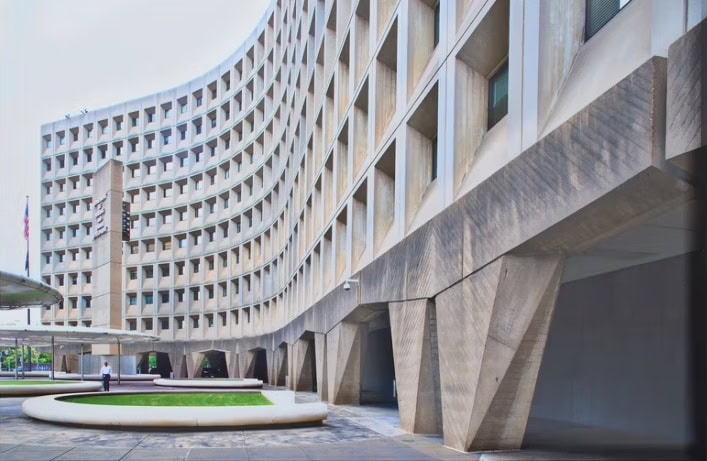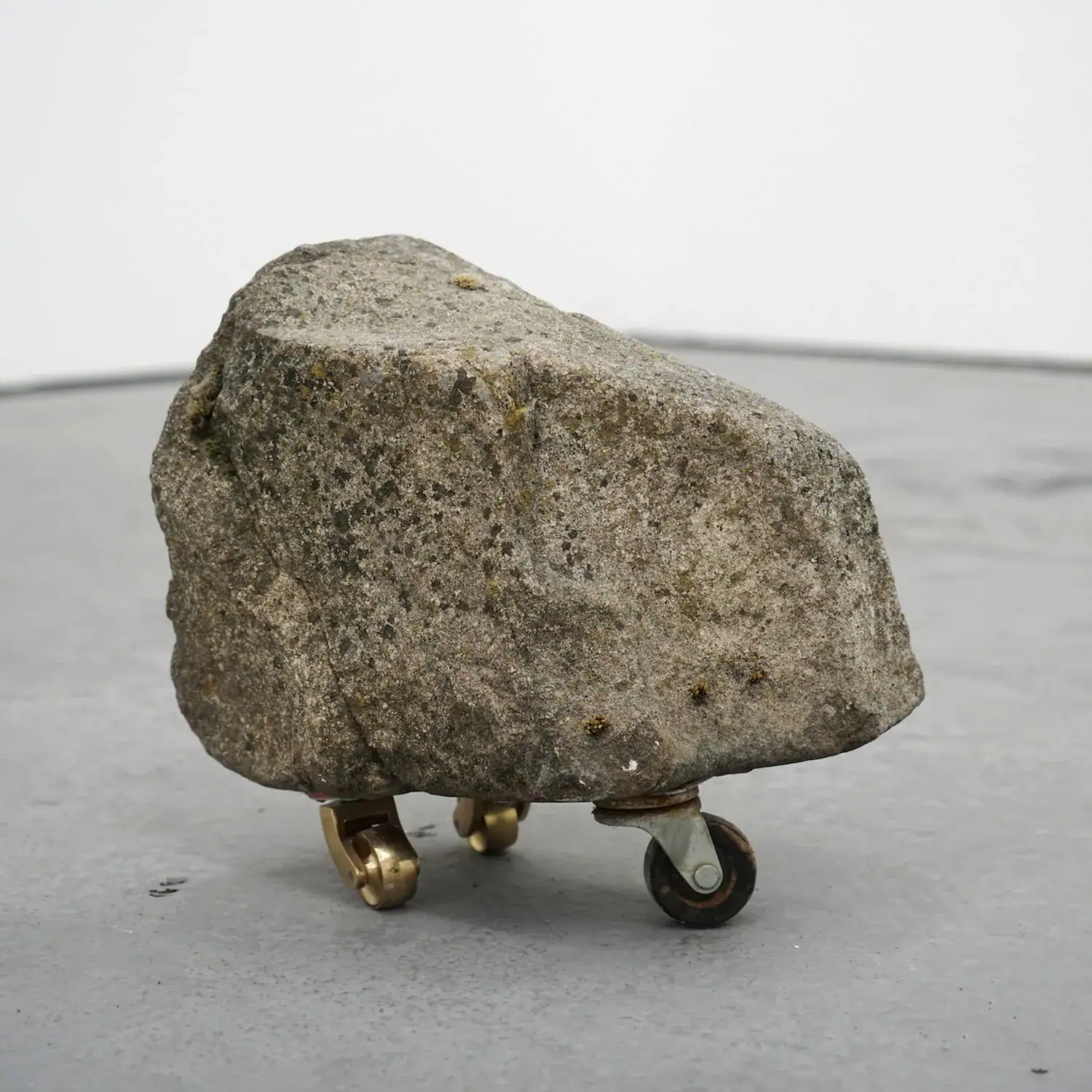notes and notices are short and curt reviews of exhibitions at (mostly) London galleries.
- Judith Dean
New Builds / Bilds 2: did you mean peace?
★★★★☆South Parade, LondonOn until 14 June 2025There is a form of aesthetic enjoyment described by Gombrich that arises when the mind solves a puzzle set by an artist for the eye. Dean’s geometric trompes skew parallaxes and perspectives, forcing the process of sensing into two. Rhomboid and polygonal canvases play host to projections and mappings, each with a Euclidian logic, in which further frames, figures, and faces compete for plane primacy.
This once baffling picture-in-picture vision of ‘90s TV sets is now second nature to the third eye which evolved at the end of the phone-clutching hand. Holbein’s skull impresses no one anymore. But Dean takes her spatial trickery seriously, loading it with temporal signatures that throw the installation to the corner of the arcade’s mirror room.
There is an unstated hierarchy of forms at work in this enigmatic not-quite-solo, not-quite-collective exhibition. “Hereafter” was conceived by Simon Moretti and features works by well over a dozen “guest” others. The artist’s wall-mounted neon, Double Vortex (after Emanuel Swedenborg), 2025, is the show’s cipher. This work’s very shape—like a ram’s horns atop an Ionic column—points to the heavens.
- Tamsin Morse, Kris Lock, Casper Scarth, et al.
The Poplar Bestiary
★★★☆☆TondoCosmic, LondonCurated by Tamsin Morse and Jennifer ThatcherOn until 12 April 2025If the gallery, like the internet, is the battleground of pornography and cat videos, the zone-three project space plays home to the two’s beastly offspring. Tamsin Morse’s pitifully contorted horse – flopped across a sizable canvas as though between the knackers’ yard and a bougie pet parlour – is this evolutionary line’s apex exponent. His human companions might weep, had they understood that his lot is their very bidding.
Kris Lock’s oil pigments are all over the conservatory, the koi pond, but also the office hot-desking station. Which species is invasive is not obvious in these eerie mistaken-identity film set backdrops. Casper Scarth’s balloon ape, scratched into paper like a Studio Ghibli ghost, deftly predates this apparition’s recent AI meme takeover. Is it too late for the animal, or even the artist to cash in on their first-mover advantage?
This menagerie comes with no humanly comprehensible challenge. How could it? The project casts a barely visible shadow on the suburban new-builds which envelop it. Stuck between the cloud and the pastoral, each painting’s edge becomes a kennel.
The success of Sudipo’s block colour and found image collages relies on hardly anyone looking at them closely. The shimmering reflections from their crumpled aluminium foil backgrounds dazzle the dimly lit gallery. The effect is seductive, certainly, even within the white cube’s commercial austerity.
But look, and it’s all on the surface. Sheets of translucent filters barely conceal borrowed, if not stolen motives. Each layer contributes even less to the history Sudipo is building than last year’s memes.
The dealer, the gallery cleaner, maybe even the artist had a chance to intervene in these objects in bright light. That they did not is, indeed, ominous.
To’s images evade representation even though on the paintings’ surface, her impulse is taxonomical. The canvases – washes of murky greens, rotten teals, and the odd flash of lifeless brown – are either isolated records of the lost, quotidian human or close-up studies of unexplained supernatural phenomena. Half-washed-off cave markings, crumbling Art Deco ornaments, and sheer rot mix to produce undecipherable records.
When they confuse the scholar, these images are captivating. But To gives her hand away too easily. Moments of clarity – ironically, the last thing one wants of her paintings – reveal that she determined each subject’s cypher before she even picked up her brush. That Lascaux bison was but a hoax.
Give it some time, however, because all evidence erodes eventually. Within an aeon or two, matter may still win over the mind.
- Dickon Drury
The Preceding Cart & POV: You are Beans
★★★☆☆Seventeen with Kendall Koppe, LondonOn until 19 April 2025It would be time to call Seventeen’s bluff on clever, well-executed painting but given that Drury – an already perfectly entertaining artist – has just sat down in a bath full of baked beans, such criticism may land one a mouthful. The painter’s insistence on amplifying what he identifies as the pictorial crisis craftily verges on the absurd. His canvases study the garden shed in the style of a Japanese mail-order brand trying to break into Europe through TikTok. Representation is only viable by preset, narratives auto-generate captions, and the hues are all but predetermined.
It’s even worse next door, where the microwave oven’s door is the very limit of objectivity. One half-resignedly scrolls through this tiresome, quotidian universality, praying the algorithm glitches out of the matrix. It does not, and it is no help that Drury is entirely right. Painting needs prophets, he still plays a jester.
Not taking the Becher’s name in vain was once the sole Düsseldorf school commandment. Welling trained elsewhere and, besides, his claim on typology is also a decades-long story. Yet this two-venue paring of the three photographers’ deadpan architectural meditations is a dead giveaway of Welling as a mere imitator.
Perhaps. The Bechers recorded industrial phenomena with such restraint that their lens critique was evident in even a single snapshot. Welling’s veneration of brutalist concrete – his lens turns to Washington’s infamous HUD building now outlawed under Trump’s classical architecture edict – borders on a fetish by contrast. But if one no longer needs to look at Bernd and Hilla’s grain silos, Welling’s quasi-opportunistic fixation leads to fresher discoveries.
- Ada Bond, Rebecca Davy, Karen Densha, Sam Owen Hull, Hilary Jack, Rachel Goodyear, Evita Ziemele, et al.
Medusa
★★★☆☆Union Gallery, LondonCurated by Mike Chavez-DawsonOn until 22 March 2025There is a mode of curating a group show which takes a title so literally that one suspects a hashtag search was engaged in its preparation. This one half-falls under Medusa’s spell: Ziemele’s chick-lit cover oils and Goodyear’s bedtime scare story watercolour are too straightforward as reflections from the myth and reveal little about who beheaded whom. Densham’s bijou gold ceramics are twisted-pretty but inconsequential in context. Dawson and Davy turn to AI but leave even it none the wiser.
The joke finally lands with Murray’s spaghetti painting and Jack’s sublimely ridiculous rock. Bond’s Gogron, for the love of myth, is painted on cheese, albeit disappointingly that cheese is not gorgonzola. Interpreting a tale this grotesque, this ugly, and, as in Hull’s maquette for a painting, venomous will take thousands of years.
The challenge which the late Finn-Kelcey’s work posed to sex and gender roles in the 1970s and 80s seems quaint today. The brand of feminism archived in her studio self-portraits as a bull matador and a casino croupier has since both proclaimed total victory and continues to make a muted demand for parity. The exhibition’s sensitive display in local-art-centre retro exposes that project’s breakdown.
But making it ‘live’ again, as Finn-Kelcey’s performances once may have done is a different challenge. Snapshots and scripts of her 1976 durational gallery lock-in with a pair of magpies are simply no match for Beuys’ time with the coyote. That the art historian at whom this display is aimed cannot agree is the movement’s tragedy.
- Anna Bunting-Branch, Choy Ka Fai, Damara Inglês, Katarzyna Krakowiak, Lawrence Lek, Kira Xonorika
What Is It Like?
★★☆☆☆Arebyte, LondonCurated by Helen StarrOn until 4 May 2025For an exhibition that claims to concern itself with “embodiment”, this slick but gimmicky display of audio, video, and VR works could not be any less intelligible through the human senses. Starr turned the dimly lit gallery into an archive vault from which visitors must themselves assemble exhibits of bewildering artefacts: game world vistas, augmented reality performances, and soundscapes inflected by programmatic AI-fi.
This physical challenge might be surmountable (audiences love interactivity, right?) but it clouds the show’s crucial concerns. Can the machine know like a human? What does it feel like for an intelligence to be artificial? What do any of the artists in this show have to say about it? And what, if anything, does that have to do with a bat?
That this is moot is Starr’s very point. Yet if art is a knowledge-generating discipline, its knowledge itself needs an art that translates it into forms. In the optimism of the Enlightenment, this process was the core of aesthetics. Today, technology and art serve to mystify each other, leaving the human out of the picture.
Inspired in form and attitude by Manhattan Art Review.









